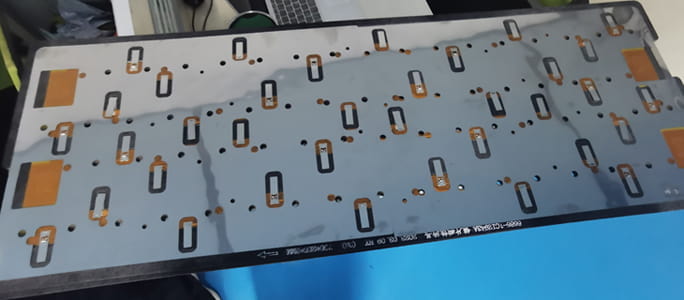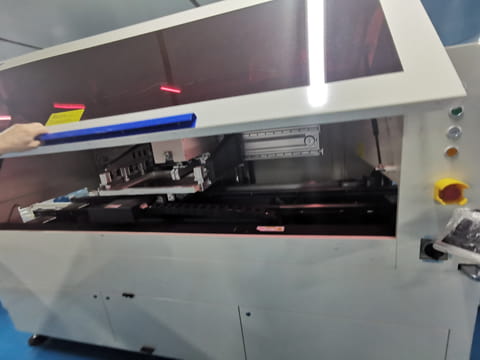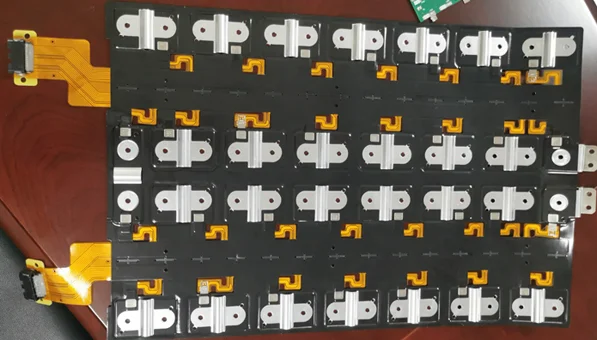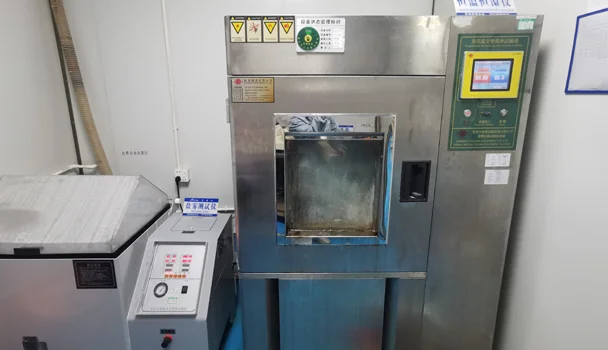How is the flexible PCB assembly process?
We know that flexible PCBs are light and bendable. Any vibration or wind can cause flexible PCBs to move, and flex PCBs are easy to roll up. So a challenge of flexible circuit board assembly is - how to fix the boards during SMT assembly. After the flexible circuit board assembly, what tests and inspections will a flex PCB manufacturer do to make sure the assemblies' quality?
This article explains everything about flexible PCB assembly. Dive to see now.
Part 1. Flexible Circuit Assembly Process
![]()
Flex circuit assembly refers to SMT assembly of flexible printed circuit boards (FPC). Electronic components can only surface mount on FPC.
Below is the flexible circuit assembly process from PCBONLINE's PCB assembly factory.
Step 1. FPC Fabrication
Of course, before flexible PCB assembly, we have to fabricate the flex PCBs. The steps are cut lamination > circuit generation on flex copper clad laminates (FCCL) > surface finish > automatic optical inspection (AOI) > cutting coverlay > attaching coverlay while solder mask opening > lamination > silkscreen printing > electrical testing.
Step 2. Baking flexible PCBs
This is optional. We only bake the flex PCBs that have been stored for quite a long period because the polyimide (PI) or polyester (PET) substrate of flexible PCBs may absorb moisture.
Step 3. Fixing flexible PCB with jigs

Before flex PCB assembly, the flex PCBs must be fixed with jigs because, as you know, flex PCBs are lightweight and easy to move or scroll. If they were not fixed with jigs, components can't be mounted on the FPC adequately.
Step 4. Flexible PCB Assembly

We place an SMT stencil in an automatic solder paste printing machine. The machine works according to the program designed by our CAM engineer.
In the machine, the flexible PCB is first dispensed with glue, which is similar to solder paste printing. Then components are picked and placed on the flex PCB to become a flexible PCBA.
Step 5. Thermal lamination

This step is not necessary. If the flex PCBA needs to be further processed to be a module, such as a current collector assembly module, the flex PCBA can be thermally laminated with other components, such as black films and nickel sheets.
The FPC source factory manufacturer PCBONLINE provides flexible PCB fabrication and assembly. Besides flex PCBA manufacturing, PCBONLINE does various tests below to guarantee the quality of FPC modules.
Part 2: Tests of Flexible PCB Assemblies
Unlike rigid PCBs, flexible PCB assemblies can't be inspected with the AOI because of their poor dimensional stability. But there are comprehensive tests from PCBONLNE to make sure the best quality of the flexible PCB assemblies.

- Tension testing: Flexible PCBA modules need to stretch in use, so we use an electrical tension tester to ensure the tension of the flex PCBA module.
- Button strike life testing: We use a button strike life tester to check the maximum times of strikes that the buttons on the flex PCBA can withstand.
- Bending testing: The bending testing is to ensure the flex PCBA's bending radius meets application requirements.

- Hand sweat testing: In module production and end-product assembly, the FPC assembly will be touched inevitably. This testing ensures the flexible PCBA quality is not affected when being touched by hands.
- Pull strength test of solder joints: After flex PCB assembly, the components are soldered on the PCB pads. This test is to evaluate the solderability strength of the solder joints.
- Environmental protection test: This test is to ensure the reliability of the flex PCBA in environments at different temperatures, and that no environmental harm occurs.

- Metallographic microscope inspection: This inspection is to check the cross-section of the flex PCB or module.
- Bridge testing: This testing is to measure the resistance, capacitance, and conductance.
- Fuse fusing testing: This test is to detect the circuit including a fuse circuit.

- Salt spray test: If the flex PCBA module is used in high salinity environments, such as on ships or seashores, a salt spray test is conducted to ensure the reliability of the module before delivery.
You can rest assured that the quality of the flex PCB assemblies and modules is fully qualified after being verified by this series of tests.
Part 3. Jigs for Flex PCB Assembly
Regular PCB assembly doesn't need jigs, but flexible PCBs need jigs to fix them during SMT assembly.
![]()
The jigs used for flexible circuit assembly include a base, a padded board (magnetic or non-magnetic), and a steel sheet for the magnetic pad. All these jigs are custom according to the flexible PCB size, positioning holes, and SMDs.
Please check the jigs one by one and how we use them below.
FPC Assembly Jig #1 - The Base
![]()
The base carries the pad board, flexible circuit board, and steel sheet. By the pin snags, it fixes the things on it.
FPC Assembly Jig #2 - The Pad Board
![]()
The padded board is used for solder paste printing, SMD mounting, and reflow soldering in the flex circuit assembly. It can be magnetic or non-magnetic. It carries the flexible PCB during assembly.
FPC Assembly Jig #3 - The Steel Sheet
![]()
The steel sheet is needed when the padboard is magnetic. It lays on the flexible PCB on the padboard to fix the circuit board. The openings of the steel sheet are for mounting SMDs on the flexible PCB.
So how do we use these jigs for flexible circuit assembly?
First, we put the base on a table and trap the pad board on the base through the pin snags.
Second, we place the flexible PCB on the pad board through the pin snags.
The third step includes two situations:
If the pad board is magnetic, we place the steel sheet on the flexible PCB through the pin snags. Then we take the pad board, FPC, and the steel sheet together from the base for flexible circuit assembly.
If the pad board is non-magnetic, we manually attach high-temperature tape on the flexible PCB to fix it on the pad board. Then we take the pad board and FPC together for flex circuit assembly.
After the flex circuit assembly, the flexible circuit board assembly will get rid of the jigs.
The flex circuit assembly using the magnetic pad board is a little more expensive than that using a non-magnetic pad. However, for bulky PCBA manufacturing, the assembly using the magnetic padded board has higher efficiency and a lower unit price.
Both the above flexible circuit assembly methods are available from PCBONLINE. Our engineer can help choose the appropriate flex circuit assembly method for your project.
Part 4. Why PCBONLINE for Flexible Circuit Assembly?
If you are looking for flexible PCB fabrication and assembly, you can work with the one-stop manufacturer PCBONLINE.
Currently, PCBONLINE can manufacture massive flex PCBAs at a maximum length of 1.2m to 1.5m, and prototypes of 1.8m. In the short future, we can make the maximum width of massive flex PCBAs 1.8m.
Reasons to have flexible PCBs fabricated and assembled from PCBONLINE:
- PCBONLINE provides one-stop flex circuit board manufacturing and assembly services.
- Our flexible PCB fabrication includes FPC laminates and finished flex circuit boards, and we reduce manufacturing costs.
- We have comprehensive tests for flexible circuit assemblies, and you don't have to test on your own.
- PCBONLINE fabricates and assembles 1 to 10-layer single-sided, double-sided, with and without adhesive, yellow, black, white, and transparent flexible PCBs.
- For bulky flex circuit assembly orders, we offer a free complete flex PCBA sample and functional testing.
- We have rich experience and can collaborate with you on research and development.
From PCBONLLINE, the minimum finished flex PCB thickness is 0.08mm, and the minimum width of the FPC is 2.36mm. We can also add stiffeners to the flex PCBs. If you have any flex circuit fabrication and assembly needs, please feel free to send your inquiry to PCBONLINE by email at info@pcbonline.com.
Conclusion
The characteristics of lightness and flexibility make flexible PCBs easy to move or roll up, so we have to fix them during flex circuit assembly. Flex circuit assembly is different from regular PCB assembly, and it requires baking FPC and assembly jigs. If the FPC quantity for flex circuit assembly is large, it's better to use the magnetic pad board and steel sheet to fix the board; if the quantity is small, it's better to use the non-magnetic pad board and high-temperature tape to fix it. For flex circuit assembly, don't miss the one-stop manufacturer PCBONLINE.
© This article is an original work of the PCBONLINE team. Please indicate the author PCBONLINE if you reprint. If the article is reproduced without permission or indicating the author's source, PCBONLINE reserves the right to investigate the infringement.




